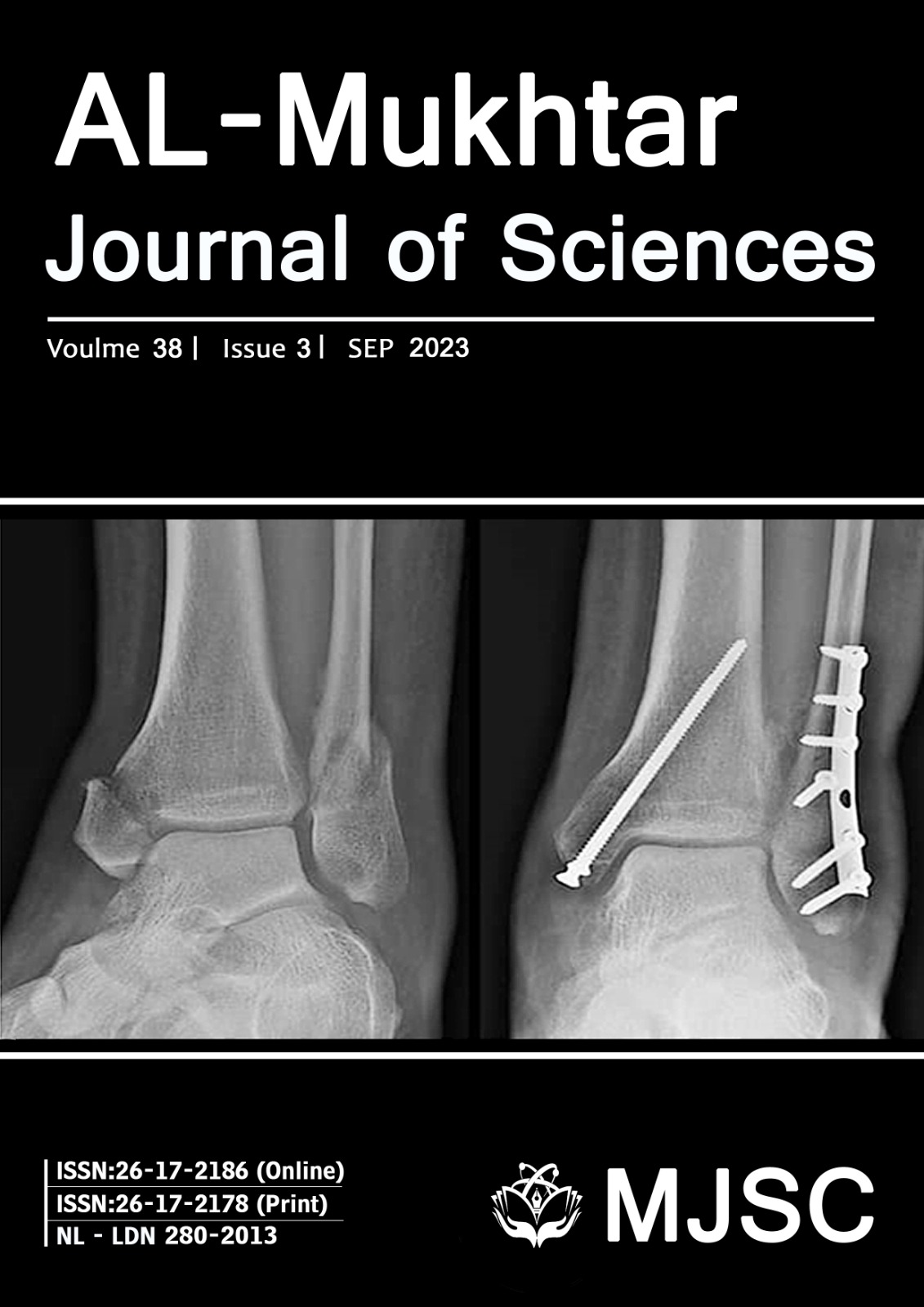Non-Compliance of Patients with Antibiotic Prescriptions
- Authors
-
-
Taher I. Shailabi
Department of Pharmacology and Toxicology, Faculty Of Pharmacy, Omar Al-Mukhtar University, LibyaAuthor -
Nisreen Saed Majeed
Department of Pharmacology and Toxicology, Faculty Of Pharmacy, Omar Al Mukhtar University, LibyaAuthor -
Elham O. Borwis
Department of Medical Microbiology, Faculty Of Medicine, Benghazi University, LibyaAuthor -
Nagat H. Bubtina
Conservative Dentistry Department, Faculty of Dentistry, Benghazi University, Benghazi, LibyaAuthor
-
- Keywords:
- Antibiotics, Bacterial resistance, Community pharmacies, Patient adherence, Libya
- Abstract
-
Non-compliance with antibiotic treatment instructions is dangerous in complete cure, increasing treatment costs and increasing the number of resistant microbes. This study aimed to assess adherence to antibiotic treatment and its associated factors in patients after visiting Libyan community pharmacies. A cross-sectional study was conducted on patients who visited community pharmacies in Libya. Several reasons for non-compliance have been reported but the main ones were it is not necessary to continue taking prescribed medications once feeling better (27.3%), polypharmacy (19.6%), fear of medication adverse effects (18.7%) and the duration of antibiotic treatment also increased the risk of non-compliance (15%). Appropriate prescribing strategies to increase the public awareness, knowledge, and attitude to ensure appropriate antimicrobial use and minimize the problem of non-compliance.
- Downloads
-
Download data is not yet available.
- References
-
Ahmed, N. J. (2020). The Rate of Adherence to Antibiotics and Reasons for Non-adherence among the Public. Journal of Pharmaceutical Research International, 32(7), 42–47. https://doi.org/10.9734/jpri/2020/v32i730458
Almomani, B. A., Hijazi, B. M., Awwad, O., & Khasawneh, R. A. (2022). Prevalence and predictors of non-adherence to short-term antibiotics: A population-based survey. PLoS ONE, 17(5 May), 1–11. https://doi.org/10.1371/journal.pone.0268285
Atia, Ahmed. (2018). Monitoring the Level of antibiotic purchase without a prescription among Libyan young adults. Indian Journal of Pharmacy Practice, 11(4), 208–211. https://doi.org/10.5530/ijopp.11.4.43
Atia, Ahmed. (2020a). Epidemiology of Self-Medication Practice among Libyans: A Systematic Review and Meta-Analysis. Preprints, June, 1–9. https://doi.org/10.20944/preprints202006.0335.v1
Atia, Ahmed, Abired, A., Ammar, A., Elyounsi, N., & Ashour, A. (2018). Prevalence and types of bacterial infections of the upper respiratory tract at a tertiary care hospital in the City of Tripoli. Libyan International Medical University Journal, 3(2), 54. https://doi.org/10.4103/liuj.liuj_23_18
Atia, Ahmed, Elyounsi, N., Abired, A., Wanis, A., & Ashour, A. (2020). Antibiotic resistance pattern of bacteria isolated from patients with upper respiratory tract infections; a four-year study in Tripoli city. Iberoamerican Journal of Medicine, 03(August), 155–160. https://doi.org/10.20944/preprints201808.0435.v1
Atia, Ahmed, Zanned, S., & Bakait, N. (2020). Exploring the Ready Knowledge of Drug Prescribing among Junior Doctors in Libya. 2020–2023. https://doi.org/10.4103/LJMS.LJMS
Atia, AhmedE, & Abired, A. (2017). Antibiotic prescribing for upper respiratory tract infections by Libyan community pharmacists and medical practitioners: An observational study. Libyan Journal of Medical Sciences, 1(2), 31. https://doi.org/10.4103/ljms.ljms_14_17
Bruyndonckx, R., Adriaenssens, N., Versporten, A., Hens, N., Monnet, D. L., Molenberghs, G., Goossens, H., Weist, K., & Coenen, S. (2021). Consumption of antibiotics in the community, European Union/European Economic Area, 1997-2017: Data collection, management and analysis. Journal of Antimicrobial Chemotherapy, 76, II2–II6. https://doi.org/10.1093/jac/dkab171
Duan, L., Liu, C., & Wang, D. (2021). The general population’s inappropriate behaviors and misunderstanding of antibiotic use in China: A systematic review and meta-analysis. Antibiotics, 10(5). https://doi.org/10.3390/antibiotics10050497
Elbabour, F., Benkhaial, A., & Elemam, R. Antibiotic Prescribing Practices in Libya: A cross-sectional Survey.
Elzahaf, R. A., Rabeea, A. A., Mohamed, F. A., Ramadan, S., Fadhlalla, A., Alkhawwajah, T. A., & Shaheen, M. K. (2021). Knowledge, Attitude and Practice Regarding to Antibiotics use among Libyan Community. Saudi J Med Pharm Sci, 4929, 599–608. https://doi.org/10.36348/sjmps.2021.v07i12.002
Falagas, M. E., Karagiannis, A. K. A., Nakouti, T., & Tansarli, G. S. (2015). Compliance with once-daily versus twice or thrice-daily administration of antibiotic regimens: A meta-analysis of randomized controlled trials. PLoS ONE, 10(1), 1–15. https://doi.org/10.1371/journal.pone.0116207
Fernandes, M., Leite, A., Basto, M., Nobre, M. A., Vieira, N., Fernandes, R., Nogueira, P., & Jorge, P. (2014). Non-adherence to antibiotic therapy in patients visiting community pharmacies. International Journal of Clinical Pharmacy, 36(1), 86–91. https://doi.org/10.1007/s11096-013-9850-4
French, G. L. (2005). Clinical impact and relevance of antibiotic resistance. Advanced Drug Delivery Reviews, 57(10), 1514–1527. https://doi.org/10.1016/j.addr.2005.04.005
Ghaieth, M. F., Elhag, S. R. M., Hussien, M. E., & Konozy, E. H. E. (2015). Antibiotics self-medication among medical and nonmedical students at two prominent Universities in Benghazi City, Libya. Journal of Pharmacy and Bioallied Sciences, 7(2), 109–115. https://doi.org/10.4103/0975-7406.154432
Jimmy, B., & Jose, J. (2011). Patient medication adherence: Measures in daily practice. Oman Medical Journal, 26(3), 155–159. https://doi.org/10.5001/omj.2011.38
Kardas, P. (2002). Patient compliance with antibiotic treatment for respiratory tract infections. Journal of Antimicrobial Chemotherapy, 49(6), 897–903. https://doi.org/10.1093/jac/dkf046
Llor, C., Hernández, S., Bayona, C., Moragas, A., Sierra, N., Hernández, M., & Miravitlles, M. (2013). A study of adherence to antibiotic treatment in ambulatory respiratory infections. International Journal of Infectious Diseases, 17(3), 168–172. https://doi.org/10.1016/j.ijid.2012.09.012
Mohammed, M. A., Alnour, T. M. S., Shakurfo, O. M., & Aburass, M. M. (2016). Prevalence and antimicrobial resistance pattern of bacterial strains isolated from patients with urinary tract infection in Messalata Central Hospital, Libya. Asian Pacific Journal of Tropical Medicine, 9(8), 771–776. https://doi.org/10.1016/j.apjtm.2016.06.011
Organization, W. H. (2012). The evolving threat of antimicrobial resistance: Options for action. WHO Publications, 1–119. www.who.int/patientsafety/en/%0Ahttp://www.ijmr.org.in/article.asp?issn=0971-5916;year=2014;volume=139;issue=1;spage=182;epage=183;aulast=Kapi
Pechère, J. C., Hughes, D., Kardas, P., & Cornaglia, G. (2007). Non-compliance with antibiotic therapy for acute community infections: a global survey. International Journal of Antimicrobial Agents, 29(3), 245–253. https://doi.org/10.1016/j.ijantimicag.2006.09.026
Shailabi, T., Aldeeb, O. H., Almaedani, A. F., Borwis, E. O., & Amer, S. A. (2022). Antimicrobial Susceptibility Patterns of Escherichia coli from Urine Isolates. Al-Mukhtar Journal of Sciences, 37(4), 372–384.
Shailabi, T. I. M., & Akrim, Z. S. M. (2021). Disposal Methods of Expired and Unused Medications among the General Public in Al-Bayda City. Al-Mukhtar Journal of Sciences, 36(3), 209–215. https://doi.org/10.54172/mjsc.v36i3.337
Thorpe, K. E., Joski, P., & Johnston, K. J. (2018). Antibiotic-resistant infection treatment costs have doubled since 2002, now exceeding $2 billion annually. Health Affairs, 37(4), 662–669. https://doi.org/10.1377/hlthaff.2017.1153
Tong, S., Pan, J., Lu, S., & Tang, J. (2018). Patient compliance with antimicrobial drugs: A Chinese survey. American Journal of Infection Control, 46(4), e25–e29. https://doi.org/10.1016/j.ajic.2018.01.008
- Downloads
- Published
- 2025-10-13
- Issue
- Vol. 38 No. 3 (2023)
- Section
- Articles
- License
-

This work is licensed under a Creative Commons Attribution-NonCommercial 4.0 International License.
Copyright of the articles Published by Almukhtar Journal of Science (MJSc) is retained by the author(s), who grant MJSc a license to publish the article. Authors also grant any third party the right to use the article freely as long as its integrity is maintained and its original authors and cite MJSc as the original publisher. Also, they accept the article remains published by the MJSc website (except in the occasion of a retraction of the article).
How to Cite
Similar Articles
- Raul I. Gambalan, Janette L. Calo, Jerlinda P. Roa, Salih A. S. Alsalimi, Compliance of Hand Hygiene Among Health Care Professionals and Allied Health Workers in the Prevention of Bacterial Contamination , Al-Mukhtar Journal of Sciences: Vol. 38 No. 4 (2023)
- Mariam M. Madany, Amenh B. Yousif, Rasmia H. Feituri, Naemia Gawbaa, Amal Khazmi, Surgical Outcomes of Congenital Heart Disease in the Eastern Region of Libya , Al-Mukhtar Journal of Sciences: Vol. 39 No. 2 (2024)
- Asma Albarasi, Hana Saied Abdulali, Amal A. Elfakhri, Hala Ammar, Prevalence and Risk Factors of Cholelithiasis Among Children with Hereditary Hemolytic Anemia: A Single Center Experience Benghazi, Libya , Al-Mukhtar Journal of Sciences: Articles in press
- Manal H. Algraiw, Huda H . Algriw, Omar I. Abusnena, Combatting Fatigue and Bone Pain: The Impact of Vitamin D Treatment in the General Practice Setting , Al-Mukhtar Journal of Sciences: Vol. 40 No. 1 (2025)
- Jebril S. Elabidi, Asmaa F. Salih, Monia F. Abusarayi, Epidemiological and Clinical Characteristics of Pediatric Urinary Tract Infections in Benghazi, Libya: A Two-Year Retrospective Study , Al-Mukhtar Journal of Sciences: Vol. 40 No. 1 (2025)
- Mabrouk S. Bohalfaya, Idris M. Tajoury, Hosam A. Ibraheem, Rehabilitation Followings Surgical Fixation of Bimalleolar Fractures , Al-Mukhtar Journal of Sciences: Vol. 38 No. 3 (2023)
- Muftah H. Elkhafifi, Abdulsalam A. Nabous, Ali T. Muftah, Giant Vesical Calculus Presented with Anuria in a Young Male Patient: A Case Report , Al-Mukhtar Journal of Sciences: Vol. 39 No. 3 (2024)
- Haleemah A. Al sheeyab, Hussain Alkhamry, Salem Omaer, Riyad Bendardaf, Cochlear Implant Complications in Children: Libyan Scenario and Experience , Al-Mukhtar Journal of Sciences: Vol. 39 No. 1 (2024)
- Hajer A. Alfadeel, Exploring Anatomical Variations of the Vermiform Appendix on Multidetector CT , Al-Mukhtar Journal of Sciences: Vol. 39 No. 1 (2024)
- Saleha A. Algusbi, Eyman I. Alrahal, Eyman N. Almagbry, Huda Z. Alkhweldy, Nagah M. Hadlol, Rayian R. Alzafiety, Sawsan A. Aldarwesh, Waad K. Alhrarie, Wegdan N. Almagbry, Study of Risk Factors for Entamoeba Histolytica in Preschool Children: A Questionnaire Survey , Al-Mukhtar Journal of Sciences: Vol. 39 No. 3 (2024)
You may also start an advanced similarity search for this article.

















